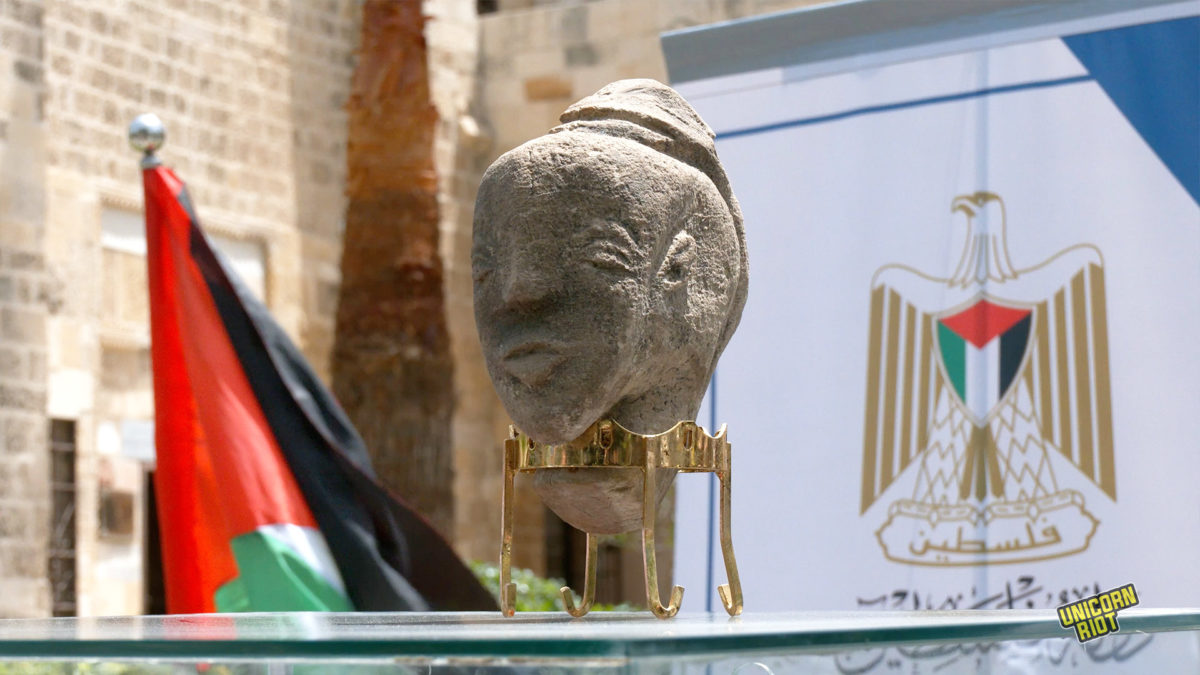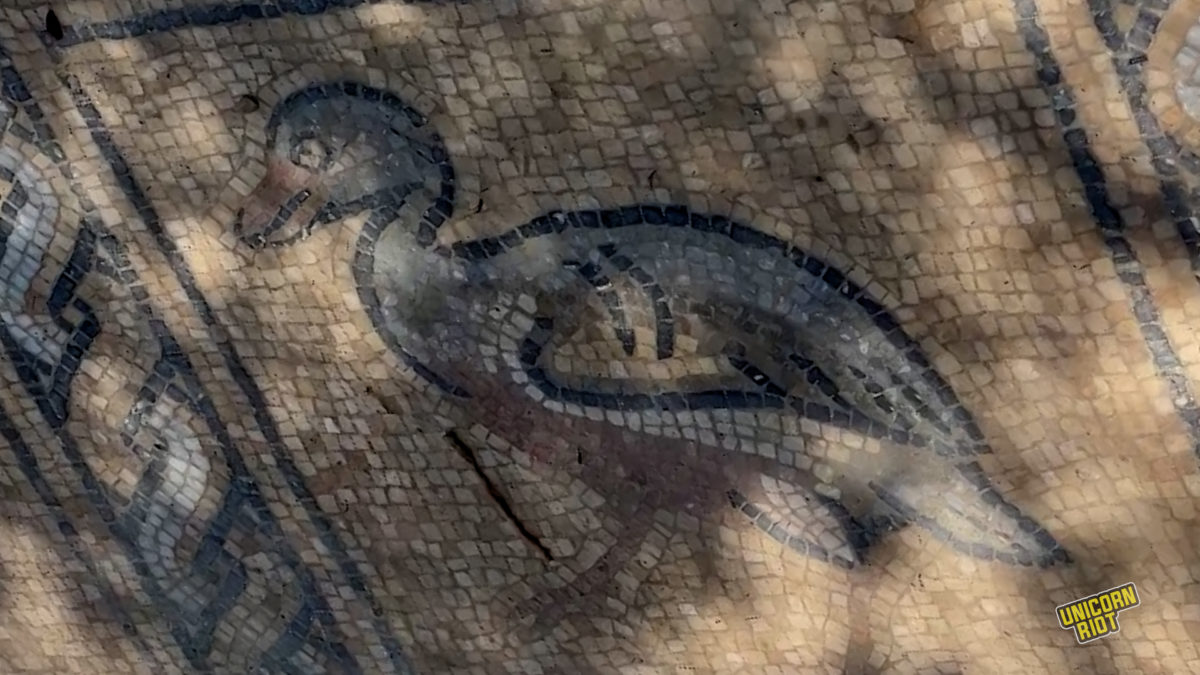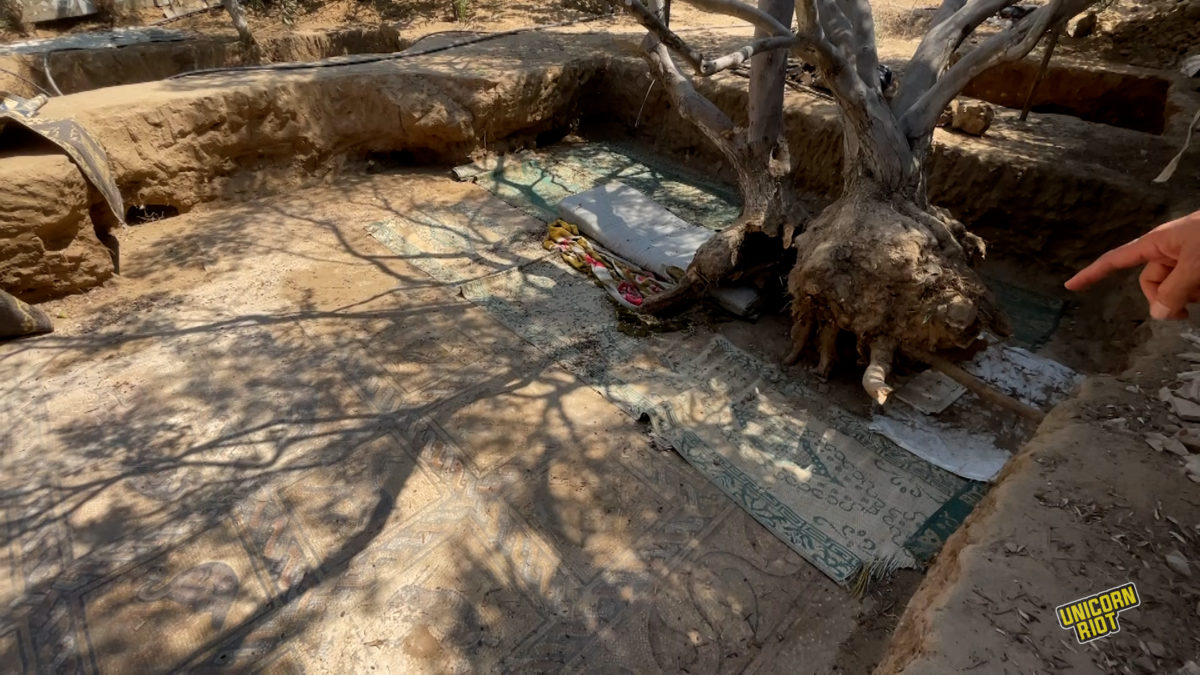Gaza Strip, Palestine – Two major discoveries in 2022 showcase thousands of years of Arab existence on Palestinian lands.
A 4,500-year-old statue of the Canaanite goddess Anat and a 1,500-year-old tiled mosaic floor were both separately found last year in the Gaza Strip, a coastal area of 140 square miles sandwiched between Israel and Egypt off the coast of the Mediterranean Sea and teeming with tales of history.
4,500-Year-Old Canaanite Statue of the Goddess of Love
While cultivating his land, a farmer unearthed an ancient Canaanite statue of what experts say depicts the Goddess Anat. Found in the city of Khan Yunis, in the southern Gaza Strip, the statue with only a head, stands a bit over eight inches tall (21cm) and is made of limestone.
A serpent is attached to the crown of the head of the statue to represent strength and invincibility. According to Canaanite mythology and belief, Anat was the goddess of love, beauty and war.
Researcher and historian Walid Al-Akkad, owner of the Al-Akkad Museum in Khan Yunis, said that the snake on the head of the statue indicated “strength and love and is evidence of the strength of the Canaanite civilization in that era.”
The Director General of Antiquities and Cultural Heritage in Gaza, Jamal Abu Rida, said the statue is 4,500-years-old and dates back to the Canaanite period of 2,500 BCE.
The discovery occurred in the Sheikh Hamouda area of Khan Yunis, an archaeological site in the east of Khan Yunis that was the ancient commercial land route for successive civilizations in Palestine.
Al-Akkad added that the area in which the statue was found is considered a high mound, inhabited by many civilizations. In the same area Akkad had previously found a coffin made of soft lead weighing 231 pounds (105 kilograms) and containing coins dating back to the Byzantine period.
“No other statue resembles this one in Gaza City,” said Nariman Khaleh the Director of Qasr al-Basha, the Pasha’s Palace Museum in Gaza City, where the ancient statue is now on display.


1,500-Year-Old Complex Floor Mosaic
Also in 2022, just a half a mile from the Israeli border in the Gaza Strip, another Palestinian farmer made an amazing discovery. In his backyard, he found a well-preserved and vividly colored mosaic floor likely from the period between the fifth and seventh centuries.
The well-preserved pavement includes 17 iconic images of beasts and birds.
“These are the most beautiful mosaic floors ever discovered in Gaza, both in terms of the quality of the graphic representation and the complexity of the geometry,” said Rene Elter, an archaeologist from the French School of the Bible and Archeology in Jerusalem.
Elter said proper excavations should be carried out to determine exactly when it was built and whether it was part of a religious or secular complex.


The British Encyclopedia defines “Canaan” as something that is “always cent[ered] on Palestine.” They further note that Palestine was inhabited by Canaanites of Semitic origins before the Israelis, and that the name Canaan and the Canaanites appeared in Egyptian and Phoenician cuneiform writings since about the fifteenth century BCE. The encyclopedia adds that the credit for our knowledge of the history of Canaan is due to archaeological discoveries as well as ancient blogs such as the Amarna letters.
According to the American archaeologist James Henry Breasted (pdf), the Canaanites are one of the Arab tribes that have settled in Palestine since the year 2,500 BCE. The ancient civilizations of Canaan and Phoenicia, both of Semitic Arab origin, settled in Palestine and Lebanon through a single migration that set out from the Arabian Peninsula in the third millennium BC.

The Canaanite civilization also extended to the Syrian regions, such as Ras Shamra (Ugarit), which is one of the important Canaanite civilization centers since the first half of the second millennium BCE, as well as the Kingdom of Ebla near Aleppo.
Neither of the discoveries noted above takes away the fact that others have lived in these lands for centuries as well. Jewish people maintain their ties to this land go back 3,700 years.
The Gaza Strip was a busy trade route between Egypt and the Levant in ancient times and is full of remnants of ancient civilizations, from the Early Bronze Age to the Islamic and Ottoman eras.
Yet, despite being a land so rich in history and archaeological areas dating back centuries, treasures of ancient civilizations are rarely protected in Palestine. An ongoing Israeli siege on Gaza and repeated bombings by Israeli forces over the last decades have negatively impacted archaeological sites and the ability to excavate. Intersecting with these attacks is the lack of concern by the ruling parties in Palestine, which negatively affect antiquities and therefore tourism in the Gaza Strip.
Found by farmers, the two discoveries of 2022 have helped push the conversation on providing better protection for antiquities in Gaza.
With several groupings of fragile sites threatened by a lack of awareness and resources, as well as the continuing danger of conflict between Israel and local Palestinian militants, many are hoping humanity can prevail in saving relics of the old world.
Niko Georgiades contributed to this report for Unicorn Riot.
Unicorn Riot's Coverage from Palestine:
- Surfing Santas in Gaza Welcome a New Year of ‘Prosperity and Happiness’ - January 4, 2023
- Palestinian Lands Seized for Israeli Military and Colony Settlements - December 14, 2022
- Gaza Flooded Due to Old Infrastructure From Israeli Blockade and Bombings - November 22, 2022
- Nablus Siege Lifted After 3+ Weeks of Collective Punishment - November 10, 2022
- Attacks and Collective Punishment, a Cycle of Palestinian-Israeli Conflict - October 18, 2022
- Murals of Eyes in Silwan Remind Jerusalem of Palestinian Struggle - October 1, 2022
- Protests in Besieged Palestinian Village Nabi Samuel Suppressed - September 25, 2022
- Over 2,200 Israeli Raids Killed 140 Palestinians Thus Far in 2022 - September 13, 2022
- Sand Sculpture on Shore of Gaza Sea Tributes Children Killed by Israeli Forces - August 31, 2022
- Clowns Visit Children in Gaza Amidst Rubble of Destroyed Houses - August 12, 2022
- Operation Breaking Dawn: Israel Kills 44 Palestinians Over Three Days - August 9, 2022
- Occupation Forces Repress Palestinians Fighting Land Grabs in the Northwestern West Bank - June 29, 2022
- Israeli Raid on Nablus Kills Two Palestinians and Wounds Many - July 25, 2022
- Palestinians Speak Out During Biden’s Visit - July 21, 2022
- Israeli Forces Suppress Protests After Court Green Lights Demolitions in Masafer Yatta - June 30, 2022
- Israeli Forces Raid Jenin, Kill Three Palestinians, Wound 10 - June 18, 2022
- Israeli Forces Assault Mourners of Young Man Dead After Israeli Attack on Al-Aqsa - June 16, 2022
- Israeli Settlers Celebrate Capturing Jerusalem, Police Arrest Palestinians - June 11, 2022
- Palestinian Investigation Finds Israel Responsible for Killing Journalist Shireen Abu Akleh - June 7, 2022
- Israel Kills 4 Palestinians in 48 Hours and Blows Up a Home - June 3, 2022
- Eyewitness Recounts Moments Israeli Forces Killed Shireen Abu Akleh - May 24, 2022
- Israeli Police Attack Funeral Procession of Palestinian-American Journalist - May 21, 2022
- Demonstrations in West Bank for Palestinian Prisoner’s Day and Jenin Camp - May 17, 2022
- Israeli Army Kills Journalist Shireen Abu Akleh - May 11, 2022
- Israeli Forces Clear Al-Aqsa for Settlers’ Tours - May 6, 2022
- Palestinians Killed While Resisting Israeli Forces in Silwad Led to More Protests - May 1, 2022
- Last Friday Prayer of Ramadan at Al-Aqsa Draws 160K Despite Strict Measures by Israeli Forces - April 30, 2022
- Man Shot by Israeli Forces During Land Day Demonstration - April 27, 2022
- Musaharati Dressed as Clowns Wake Up Citizens in Gaza Strip for Meal Before Ramadan Fast - April 25, 2022
- Israeli Airstrikes Hit Gaza, Iron Dome Explodes Missiles - April 22, 2022
- Israeli Airstrikes Target Gaza - April 19, 2022
- Al-Aqsa Mosque Stormed: Israeli Police Detain 400, Injure 153 - April 15, 2022
- Israeli Raids on Jenin Refugee Camp Leave Many Dead, Dozens Shot - April 15, 2022
- Palestinian Protesters Fight Occupation on Mount Sabih, Nablus - April 15, 2022
- Interview: First Ukrainian Refugee Arrives in Gaza Strip - April 14, 2022
- Palestinians Commemorate Land Day with Demos in Negev & Gaza - April 12, 2022
- Israeli Forces Stifle Religious Freedoms During Ramadan - April 5, 2022
- Palestinians Prevented from Reaching Confiscated Lands in Qusra, Gassed by Occupation Forces - March 31, 2022
- Palestinians Protest Israeli Colony Outposts in Northern West Bank - March 22, 2022
Follow us on Twitter, Facebook, YouTube, Vimeo, Instagram, Mastodon and Patreon.
Please consider a tax-deductible donation to help sustain our horizontally-organized, non-profit media organization:

The post Ancient Antiquities Discovered in Palestine’s Gaza Strip appeared first on UNICORN RIOT.
by Unicorn Riot via UNICORN RIOT

No comments:
Post a Comment